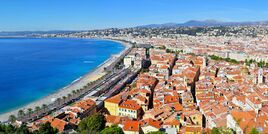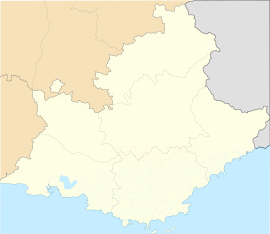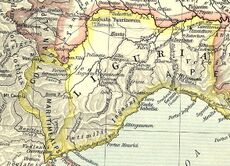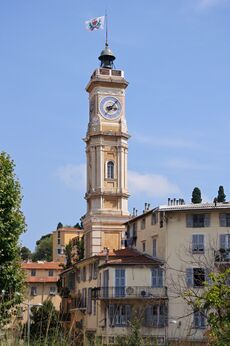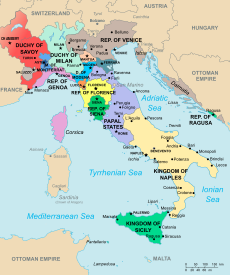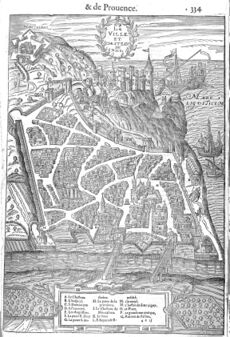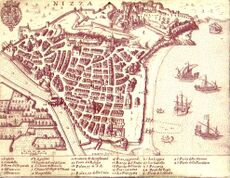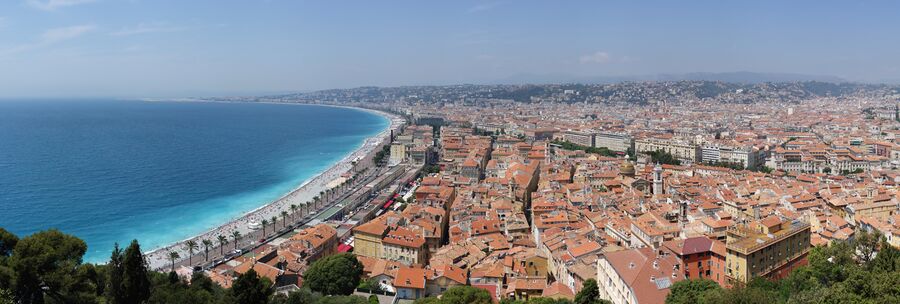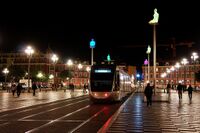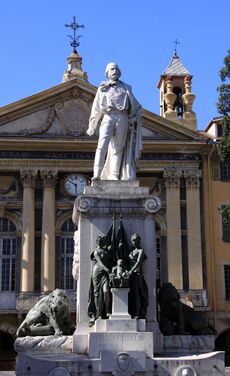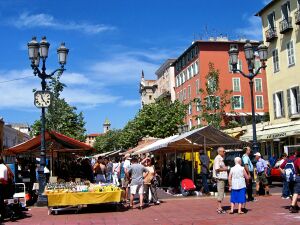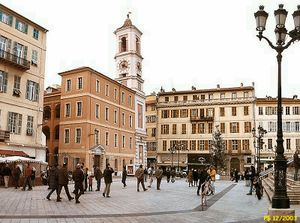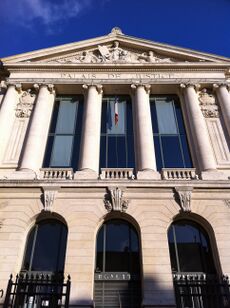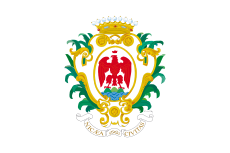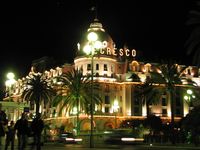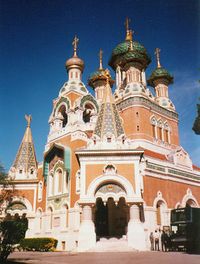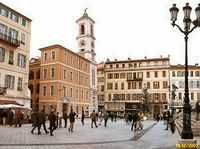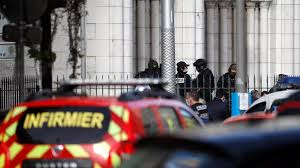نيس
Nice
Niça (أوكسيتان) | |
|---|---|
Prefecture and commune | |
The city of Nice and several of its landmarks | |
| الشعار: Nicæa civitas fidelissima (Latin: Nice, most loyal city) | |
| الإحداثيات: 43°42′12″N 7°15′59″E / 43.7034°N 7.2663°ECoordinates: 43°42′12″N 7°15′59″E / 43.7034°N 7.2663°E | |
| البلد | فرنسا |
| المنطقة | پروڤنس-ألپ-كوت دازور |
| الإقليم | الألپ البحرية (إقليم فرنسي) |
| الدائرة | Nice |
| الكانتون | Nice-1, 2, 3, 4, 5, 6, 7, 8, and 9 |
| بينالتجمعات | Métropole Nice Côte d'Azur |
| الحكومة | |
| • العمدة (2020–2026) | Christian Estrosi[1] (LR) |
| المساحة 1 | 71٫92 كم² (27٫77 ميل²) |
| • الحضر | 743٫6 كم² (287٫1 ميل²) |
| • العمران | 2٬073 كم² (800 ميل²) |
| التعداد (يناير 2019) | 342٬669 |
| • الترتيب | 5th in France |
| • الكثافة | 4٬800/km2 (12٬000/sq mi) |
| • Urban (2018[2]) | 944٬321 |
| • الكثافة الحضرية | 1٬300/km2 (3٬300/sq mi) |
| • العمرانية (2018[2]) | 609٬695 |
| • الكثافة العمرانية | 290/km2 (760/sq mi) |
| صفة المواطن | Niçois (m) Niçoise (f) |
| منطقة التوقيت | UTC+01:00 (CET) |
| • الصيف (التوقيت الصيفي) | UTC+02:00 (CEST) |
| INSEE/الرمز البريدي | 06088 / |
| الموقع الإلكتروني | www |
| موقع تراث عالمي لليونسكو | |
| Official name | Nice, Winter Resort Town of the Riviera |
| السمات | Cultural: ii |
| مراجع | 1635 |
| التدوين | 2021 (45 Session) |
| 1 French Land Register data, which excludes lakes, ponds, glaciers > 1 km2 (0.386 sq mi or 247 acres) and river estuaries. | |
نيس ( Nice ؛ /niːs/ NEESS, النطق الفرنسي: [nis] (![]() استمع); Niçard: Niça, classical norm, or Nissa, nonstandard, تُنطق [ˈnisa]; إيطالية: Nizza النطق بالإيطالية: [ˈnittsa]; الليگورية: Nissa; باليونانية قديمة: Νίκαια; لاتينية: Nicaea) هي مدينة تقع في جنوب فرنسا، على ساحل البحر المتوسط، بين مارسيليا وجنوى، في مقاطعة الألب وكوت دازور في الريڤييرا الفرنسية. يبلغ عدد سكانها نحو مليون نسمة (عام 2020)، ومساحتها 71.92 كم². تعتبر المدينة مركزاً سياحياً رئيسياً في البلاد.[3][2]
استمع); Niçard: Niça, classical norm, or Nissa, nonstandard, تُنطق [ˈnisa]; إيطالية: Nizza النطق بالإيطالية: [ˈnittsa]; الليگورية: Nissa; باليونانية قديمة: Νίκαια; لاتينية: Nicaea) هي مدينة تقع في جنوب فرنسا، على ساحل البحر المتوسط، بين مارسيليا وجنوى، في مقاطعة الألب وكوت دازور في الريڤييرا الفرنسية. يبلغ عدد سكانها نحو مليون نسمة (عام 2020)، ومساحتها 71.92 كم². تعتبر المدينة مركزاً سياحياً رئيسياً في البلاد.[3][2]
The city is nicknamed Nice la Belle (Nissa La Bella in Niçard), meaning 'Nice the Beautiful', which is also the title of the unofficial anthem of Nice, written by Menica Rondelly in 1912. The area of today's Nice contains Terra Amata, an archaeological site which displays evidence of a very early use of fire 380,000 years ago. Around 350 BC, Greeks of Marseille founded a permanent settlement and called it Νίκαια, Nikaia, after Nike, the goddess of victory.[4] Through the ages, the town has changed hands many times. Its strategic location and port significantly contributed to its maritime strength. From 1388 it was a dominion of Savoy, then became part of the French First Republic between 1792 and 1815, when it was returned to the Kingdom of Piedmont-Sardinia, the legal predecessor of the Kingdom of Italy, until its re-annexation by France in 1860.
The natural environment of the Nice area and its mild Mediterranean climate came to the attention of the English upper classes in the second half of the 18th century, when an increasing number of aristocratic families took to spending their winters there. In 1931, following its refurbishment the city's main seaside promenade, the Promenade des Anglais ("Walkway of the English"), was inaugurated by Prince Arthur, Duke of Connaught; it owes its name to visitors to the resort.[5] These included Queen Victoria along with her son Edward VII who spent winters there, as well as Henry Cavendish, born in Nice, who discovered hydrogen.
The clear air and soft light have particularly appealed to notable painters, such as Marc Chagall, Henri Matisse, Niki de Saint Phalle and Arman. Their work is commemorated in many of the city's museums, including Musée Marc Chagall, Musée Matisse and Musée des Beaux-Arts.[6] International writers have also been attracted and inspired by the city. Frank Harris wrote several books including his autobiography My Life and Loves in Nice. Friedrich Nietzsche spent six consecutive winters in Nice, and wrote Thus Spoke Zarathustra here. Additionally, Russian writer Anton Chekhov completed his play Three Sisters while living in Nice.
Nice's appeal extended to the Russian upper classes. Prince Nicholas Alexandrovich, heir apparent to Imperial Russia, died in Nice and was a patron of the Russian Orthodox Cemetery, Nice where Princess Catherine Dolgorukova, morganatic wife of the Tsar Alexander II of Russia, is buried. Also buried there are General Dmitry Shcherbachev and General Nikolai Yudenich, leaders of the anti-Communist White Movement.
Those interred at the Cimetière du Château include celebrated jeweler Alfred Van Cleef, Emil Jellinek-Mercedes, founder of the Mercedes car company, film director Louis Feuillade, poet Agathe-Sophie Sasserno, dancer Carolina Otero, Asterix comics creator René Goscinny, The Phantom of the Opera author Gaston Leroux, French prime minister Léon Gambetta, and the first president of the International Court of Justice José Gustavo Guerrero.
Because of its historical importance as a winter resort town for the European aristocracy and the resulting mix of cultures found in the city, UNESCO proclaimed Nice a World Heritage Site in 2021.[7] The city has the second largest hotel capacity in the country,[8] and it is the second most visited metropolis in Metropolitan France, receiving 4 million tourists every year.[9] It also has the third busiest airport in France, after the two main Parisian ones.[10] It is the historical capital city of the County of Nice (فرنسية: Comté de Nice, Niçard: Countèa de Nissa).[11]
. . . . . . . . . . . . . . . . . . . . . . . . . . . . . . . . . . . . . . . . . . . . . . . . . . . . . . . . . . . . . . . . . . . . . . . . . . . . . . . . . . . . . . . . . . . . . . . . . . . . . . . . . . . . . . . . . . . . . . . . . . . . . . . . . . . . . . . . . . . . . . . . . . . . . . . . . . . . . . . . . . . . . . . .
التاريخ
Foundation
The first known hominid settlements in the Nice area date back about 400,000 years (homo erectus);[12] the Terra Amata archeological site shows one of the earliest uses of fire, construction of houses, as well as flint findings dated to around 230,000 years ago.[13] Nice was probably founded around 350 BC by colonists from the Greek city of Phocaea in western Anatolia. It was given the name of Níkaia (Νίκαια) in honour of a victory over the neighbouring Ligurians (people from the northwest of Italy, probably the Vediantii kingdom); Nike (Νίκη) was the Greek goddess of victory. The city soon became one of the busiest trading ports on the Ligurian coast; but it had an important rival in the Roman town of Cemenelum, which continued to exist as a separate city until the time of the Lombard invasions.[11] The ruins of Cemenelum are in Cimiez, now a district of Nice.
Early development
In the 7th century, Nice joined the Genoese League formed by the towns of Liguria. In 729 the city repulsed the Saracens; but in 859 and again in 880 the Saracens pillaged and burned it, and for most of the 10th century remained masters of the surrounding country.[11]
During the Middle Ages, Nice participated in the wars and history of Italy. As an ally of Pisa it was the enemy of Genoa, and both the King of France and the Holy Roman Emperor endeavoured to subjugate it; but in spite of this it maintained its municipal liberties. During the 13th and 14th centuries the city fell more than once into the hands of the Counts of Provence,[11] but it regained its independence even though related to Genoa.
The medieval city walls surrounded the Old Town. The landward side was protected by the River Paillon, which was later covered over and is now the tram route towards the Acropolis. The east side of the town was protected by fortifications on Castle Hill. Another river flowed into the port on the east side of Castle Hill. Engravings suggest that the port area was also defended by walls. Under Monoprix in Place de Garibaldi are excavated remains of a well-defended city gate on the main road from Turin.[بحاجة لمصدر]
Duchy of Savoy
In 1388, the commune placed itself under the protection of the Counts of Savoy.[11] Nice participated – directly or indirectly – in the history of Savoy until 1860.[بحاجة لمصدر]
The maritime strength of Nice now rapidly increased until it was able to cope with the Barbary pirates; the fortifications were largely extended and the roads to the city improved.[11] In 1561 Emmanuel Philibert, Duke of Savoy abolished the use of Latin as an administrative language and established the Italian language as the official language of government affairs in Nice.
During the struggle between Francis I and Charles V great damage was caused by the passage of the armies invading Provence; pestilence and famine raged in the city for several years.[11] In 1538, in the nearby town of Villeneuve-Loubet, through the mediation of Pope Paul III, the two monarchs concluded a ten years' truce.[14]
In 1543, Nice was attacked by the united Franco-Ottoman forces of Francis I and Barbarossa Hayreddin Pasha, in the Siege of Nice; though the inhabitants repulsed the assault which followed the terrible bombardment, they were ultimately compelled to surrender, and Barbarossa was allowed to pillage the city and to carry off 2,500 captives. Pestilence appeared again in 1550 and 1580.[11]
In 1600, Nice was briefly taken by the Duke of Guise. By opening the ports of the county to all nations, and proclaiming full freedom of trade (1626), the commerce of the city was given great stimulus, the noble families taking part in its mercantile enterprises.[11]
Captured by Nicolas Catinat in 1691, Nice was restored to Savoy in 1696; but it was again besieged by the French in 1705, and in the following year its citadel and ramparts were demolished.[11]
Kingdom of Sardinia
The Treaty of Utrecht (1713) once more gave the city back to the Duke of Savoy, who was on that same occasion recognised as King of Sicily. In the peaceful years which followed, the "new town" was built. From 1744 until the Treaty of Aix-la-Chapelle (1748) the French and Spaniards were again in possession.
In 1775 the king, who in 1718 had swapped his sovereignty of Sicily for the Kingdom of Sardinia, destroyed all that remained of the ancient liberties of the commune. Conquered in 1792 by the armies of the First French Republic, the County of Nice continued to be part of France until 1814; but after that date it reverted to the Kingdom of Piedmont-Sardinia.[11]
French annexation

After the Treaty of Turin was signed in 1860 between the Sardinian king and Napoleon III as a consequence of the Plombières Agreement, the county was again and definitively ceded to France as a territorial reward for French assistance in the Second Italian War of Independence against Austria, which saw Lombardy united with Piedmont-Sardinia. King Victor-Emmanuel II, on April 1, 1860, solemnly asked the population to accept the change of sovereignty, in the name of Italian unity, and the cession was ratified by a regional referendum. Italophile manifestations and the acclamation of an "Italian Nice" by the crowd are reported on this occasion.[15] A plebiscite was voted on April 15 and April 16, 1860. The opponents of annexation called for abstention, hence the very high abstention rate. The "yes" vote won 83% of registered voters throughout the county of Nice and 86% in Nice, partly thanks to pressure from the authorities.[4] This is the result of a masterful operation of information control by the French and Piedmontese governments, in order to influence the outcome of the vote in relation to the decisions already taken.[16] The irregularities in the plebiscite voting operations were evident. The case of Levens is emblematic: the same official sources recorded, faced with only 407 voters, 481 votes cast, naturally almost all in favor of joining France.[17]
The Italian language that was the official language of the County, used by the Church, at the town hall, taught in schools, used in theaters and at the Opera, was immediately abolished and replaced by French.[18][19] Discontent over annexation to France led to the emigration of a large part of the Italophile population, also accelerated by Italian unification after 1861. A quarter of the population of Nice, around 11,000 people from Nice, decided to voluntarily exile to Italy.[20][21] The emigration of a quarter of the Niçard Italians to Italy took the name of Niçard exodus. Many Italians from Nizza then moved to the Ligurian towns of Ventimiglia, Bordighera and Ospedaletti,[22] giving rise to a local branch of the movement of the Italian irredentists which considered the re-acquisition of Nice to be one of their nationalist goals. Giuseppe Garibaldi, born in Nice, strongly opposed the cession to France, arguing that the ballot was rigged by the French. Furthermore, for the niçard general his hometown was unquestionably Italian. Politically, the liberals of Nice and the partisans of Garibaldi also appreciated very little Napoleonic authoritarianism. Elements on the right (aristocrats) as on the left (Garibaldians) therefore wanted Nice to return to Italy. Savoy was also transferred to the French crown by similar means.
In 1871, during the first free elections in the County, the pro-Italian lists obtained almost all the votes in the legislative elections (26,534 votes out of 29,428 votes cast), and Garibaldi was elected deputy at the National Assembly. Pro-Italians took to the streets cheering "Viva Nizza! Viva Garibaldi!". The French government sent 10,000 soldiers to Nice, closed the Italian newspaper Il Diritto di Nizza and imprisoned several demonstrators. The population of Nice rose up from February 8 to 10 and the three days of demonstration took the name of "Niçard Vespers". The revolt was suppressed by French troops. On February 13, Garibaldi was not allowed to speak at the French parliament meeting in Bordeaux to ask for the reunification of Nice to the newborn Italian unitary state, and he resigned from his post as deputy.[23] The failure of Vespers led to the expulsion of the last pro-Italian intellectuals from Nice, such as Luciano Mereu or Giuseppe Bres, who were expelled or deported.
The pro-Italian irredentist movement persisted throughout the period 1860–1914, despite the repression carried out since the annexation. The French government implemented a policy of Francization of society, language and culture.[24] The toponyms of the communes of the ancient County have been francized, which acted as a bank to the obligation to use French in Nice,[25] as well as certain surnames (for example the Italian surname "Bianchi" was francized into "Leblanc", and the Italian surname "Del Ponte" was francized into "Dupont").[26]
Italian-language newspapers in Nice were banned. In 1861, La Voce di Nizza was closed (temporarily reopened during the Niçard Vespers), followed by Il Diritto di Nizza, closed in 1871.[23] In 1895 it was the turn of Il Pensiero di Nizza, accused of irredentism. Many journalists and writers from Nice wrote in these newspapers in Italian. Among these are Enrico Sappia, Giuseppe André, Giuseppe Bres, Eugenio Cais di Pierlas and others.
جوسپه گاريبالدي، المولود في نيس, عارض بشدة ضم نيس إلى فرنسا (محتجاً بأن الضم لم يقترع عليه "عالمياً") وفي 1866 تصاعد الأمر إلا اضطرابات شعبية في المدينة, نظمها "الگاريبالديني" المطالبون بضم نيس إلى إيطاليا. الإنفصاليون الإيطاليون Italia irredenta اعتبروا نيس أحد مطالبهم الوطنية الرئيسية وفي 1942/3 تم احتلال المدينة من قبل إيطاليا أثناء الحرب العالمية الثانية.
. . . . . . . . . . . . . . . . . . . . . . . . . . . . . . . . . . . . . . . . . . . . . . . . . . . . . . . . . . . . . . . . . . . . . . . . . . . . . . . . . . . . . . . . . . . . . . . . . . . . . . . . . . . . . . . . . . . . . . . . . . . . . . . . . . . . . . . . . . . . . . . . . . . . . . . . . . . . . . . . . . . . . . . .
20th century
In 1900, the Tramway de Nice electrified its horse-drawn streetcars and spread its network to the entire département from Menton to Cagnes-sur-Mer. By the 1930s more bus connections were added in the area.[بحاجة لمصدر] In the 1930s, Nice hosted international car racing in the Formula Libre (predecessor to Formula One) on the so-called Circuit Nice. The circuit started along the waterfront just south of the Jardin Albert I, then headed westward along the Promenade des Anglais followed by a hairpin turn at the Hotel Negresco to come back eastward and around the Jardin Albert I before heading again east along the beach on the Quai des Etats-Unis.[27]
As war broke out in September 1939, Nice became a city of refuge for many displaced foreigners, notably Jews fleeing the Nazi progression into Eastern Europe. From Nice many sought further shelter in the French colonies, Morocco and North and South America. After July 1940 and the establishment of the Vichy Regime, antisemitic aggressions accelerated the exodus, starting in July 1941 and continuing through 1942. On 26 August 1942, 655 Jews of foreign origin were rounded up by the Laval government and interned in the Auvare barracks. Of these, 560 were deported to Drancy internment camp on 31 August 1942. Due to the activity of the Jewish banker Angelo Donati and of the Capuchin friar Père Marie-Benoît the local authorities hindered the application of anti-Jewish Vichy laws.[28]
The first résistants to the new regime were a group of high school seniors of the Lycée de Nice, now fr (Lycée Masséna), in September 1940, later arrested and executed in 1944 near Castellane. The first public demonstrations occurred on 14 July 1942 when several hundred protesters took to the streets along the Avenue de la Victoire and in the Place Masséna. In November 1942 German troops moved into most of unoccupied France, but Italian troops moved into a smaller zone including Nice. A certain ambivalence remained among the population, many of whom were recent immigrants of Italian ancestry. However, the resistance gained momentum after the Italian surrender in 1943 when the German army occupied the former Italian zone. Reprisals intensified between December 1943 and July 1944, when many partisans were tortured and executed by the local Gestapo and the French Milice. American paratroopers entered the city on 30 August 1944 and Nice was finally liberated. The consequences of the war were heavy: the population decreased by 15%[بحاجة لمصدر] and economic life was totally disrupted.
In the second half of the 20th century, Nice enjoyed an economic boom primarily driven by tourism and construction. Two men dominated this period: Jean Médecin, mayor for 33 years from 1928 to 1943 and from 1947 to 1965, and his son Jacques, mayor for 24 years from 1966 to 1990. Under their leadership, there was extensive urban renewal, including many new constructions. These included the convention centre, theatres, new thoroughfares and expressways. The arrival of the Pieds-Noirs, refugees from Algeria after 1962 independence, also gave the city a boost and somewhat changed the make-up of its population and traditional views.[بحاجة لمصدر] By the late 1980s, rumors of political corruption in the city government surfaced; and eventually formal accusations against Jacques Médecin forced him to flee France in 1990. Later arrested in Uruguay in 1993, he was extradited back to France in 1994, convicted of several counts of corruption and associated crimes and sentenced to imprisonment.
On 16 October 1979, a landslide and an undersea slide caused two tsunamis that hit the western coast of Nice; these events killed between 8 and 23 people.
21st century
In February 2001, European leaders met in Nice to negotiate and sign what is now the Treaty of Nice, amending the institutions of the European Union.[29]
In 2003, local Chief Prosecutor Éric de Montgolfier alleged that some judicial cases involving local personalities had been suspiciously derailed by the local judiciary, which he suspected of having unhealthy contacts through Masonic lodges with the defendants. A controversial official report stated later that Montgolfier had made unwarranted accusations.[بحاجة لمصدر]
On 14 July 2016, a truck was deliberately driven into a crowd of people by Mohamed Lahouaiej-Bouhlel on the Promenade des Anglais. The crowd was watching a fireworks display in celebration of Bastille Day.[30] A total of 87 people were killed, including the perpetrator, who was shot dead by police.[31][32] Another 434 were injured, with 52 in critical care and 25 in intensive care, according to the Paris prosecutor.[33] On 29 October 2020, a stabbing attack killed three people at the local Notre-Dame de Nice. One of the victims, a woman, was beheaded by the attacker.[34] Several additional victims were injured. The attacker, who was shot by the police, was taken into custody. The Islamic state claimed responsibility for both attacks.[35]
In 2021, the city was proclaimed a World Heritage Site by UNESCO as "Nice, Winter Resort Town of the Riviera".[7]
العمارة
The Promenade des Anglais ("Promenade of the English") is a promenade along the Baie des Anges ("Bay of the Angels"), which is a bay of the Mediterranean in Nice. Before Nice was urbanised, the coastline at Nice was just bordered by a deserted stretch of shingle beach (covered with large pebbles). The first houses were located on higher ground well away from the sea, as wealthy tourists visiting Nice in the 18th century did not come for the beach, but for the gentle winter weather.[بحاجة لمصدر] The areas close to the water were home to Nice's dockworkers and fishermen.
In the second half of the 18th century, many wealthy English people took to spending the winter in Nice, enjoying the panorama along the coast. This early aristocratic English colony conceived the building of a promenade with the leadership and financial support of Rev. Lewis Way.[36] With the initial promenade completed, the city of Nice, intrigued by the prospect, greatly increased the scope of the work. The Promenade was first called the Camin dei Anglès (the English Way) by the Niçois in their native dialect Nissart. In 1823, the promenade was named La Promenade des Anglais by the French, a name that would stick after the annexation of Nice by France in 1860.[37]
The Hotel Negresco on the Promenade des Anglais was named after Henri Negresco who had the palatial hotel constructed in 1912. In keeping with the conventions of the time, when the Negresco first opened in 1913 its front opened on the side opposite the Mediterranean.[بحاجة لمصدر]
Another place worth mentioning is the small street parallel to the Promenade des Anglais, leading from Nice's downtown, beginning at Place Masséna and running parallel to the promenade in the direction of the airport for a short distance of about 4 blocks. This section of the city is referred to as the "Zone Pietonne", or "Pedestrian Zone". Cars are not allowed (with exception to delivery trucks), making this avenue a popular walkway.
Old Nice is also home to the Opéra de Nice. It was constructed at the end of the 19th century under the design of François Aune, to replace King Charles Félix's Maccarani Theater. Today, it is open to the public and provides a regular program of performances.
Other sights include:
- Palais communal de Nice
- Palais de la Méditerranée
- Palais de l'agriculture
- Gare du Sud
- Jardin Albert-Ier
- Castle of Nice
Religious buildings
Religious buildings in the city include:
- Nice Cathedral
- Notre-Dame de Nice
- Russian Orthodox Cathedral, Nice
- Église Notre-Dame-du-Port de Nice
- Church of Gesù, Nice
Museums
Squares
. . . . . . . . . . . . . . . . . . . . . . . . . . . . . . . . . . . . . . . . . . . . . . . . . . . . . . . . . . . . . . . . . . . . . . . . . . . . . . . . . . . . . . . . . . . . . . . . . . . . . . . . . . . . . . . . . . . . . . . . . . . . . . . . . . . . . . . . . . . . . . . . . . . . . . . . . . . . . . . . . . . . . . . .
Place Masséna
The Place Masséna is the main square of the city. Before the Paillon River was covered over, the Pont-Neuf was the only practicable way between the old town and the modern one. The square was thus divided into two parts (North and South) in 1824. With the demolition of the Masséna Casino in 1979, the Place Masséna became more spacious and less dense and is now bordered by red ochre buildings of Italian architecture.
The recent rebuilding of the tramline gave the square back to the pedestrians, restoring its status as a real Mediterranean square. It is lined with palm trees and stone pines, instead of being the rectangular roundabout of sorts it had become over the years. Since its construction, the Place Masséna has always been the spot for great public events. It is used for concerts, and particularly during the summer festivals, the Corso carnavalesque (carnival parade) in February, the military procession of 14 July (Bastille Day) or other traditional celebrations and banquets.
The Place Masséna is a two-minute walk from the Promenade des Anglais, old town, town centre, and Albert I Garden (Jardin Albert Ier). It is also a large crossroads between several of the main streets of the city: avenue Jean Médecin, avenue Félix Faure, boulevard Jean Jaurès, avenue de Verdun and rue Gioffredo.
Place Garibaldi
The Place Garibaldi also stands out for its architecture and history. It is named after Giuseppe Garibaldi, hero of the Italian unification (born in Nice in 1807 when Nice was part of the Napoleonic Empire, before reverting to the Kingdom of Piedmont-Sardinia). The square was built at the end of the 18th century and served as the entry gate to the city and end of the road from Turin. It took several names between 1780 and 1870 (Plaça Pairoulièra, Place de la République, Place Napoléon, Place d'Armes, Place Saint-Augustin, Piazza Vittorio) and finally Place Garibaldi in September 1870.
A statue of Garibaldi, who was fiercely in favour of the union of Nice with Italy, stands in the centre of the square. The recent rebuilding of the area to accommodate the new tramway line gave mostly the entire square to pedestrians. The architecture is in line with the Turin model, which was the norm of urban renewal throughout the entire realm of the House of Savoy.
It is a crossroads between the Vieux Nice (old town) and the town centre. Place Garibaldi is close to the eastern districts of Nice, Port Lympia (Lympia Harbour), and the TNL commercial centre. This square is also a junction of several important streets: the boulevard Jean-Jaurès, the avenue de la République, the rue Cassini and the rue Catherine-Ségurane.
Place Rossetti
Entirely enclosed and pedestrianised, this square is located in the heart of the old town. With typical buildings in red and yellow ochres surrounding the square, the cathédrale Sainte-Réparate and the fountain in the centre, place Rossetti is a must-see spot in the old town. By day, the place is invaded by the terraces of traditional restaurants and the finest ice-cream makers. By night, the environment changes radically, with tourists and youths flocking to the square, where music reverberates on the walls of the small square. The square's lighting at night gives it a magical aspect.
Place Rossetti is in the centre of the old town, streets Jesus, Rossetti, Mascoïnat and the Pont-vieux (old bridge)
Cours Saleya
The Cours Saleya is situated parallel to the Quai des États-Unis. In the past, it belonged to the upper classes. It is probably the most traditional square of the town, with its daily flower market. The Cours Saleya also opens on the Palais des Rois Sardes (Palace of the Kings of Sardinia). In the present, the court is mostly a place of entertainment.
Place du Palais
As its name indicates, the Place du Palais is where the Palais de la Justice (Law courts) of Nice is located. On this square, there also is the Palais Rusca, which also belongs to the justice department (home of the tribunal de grande instance).
The square is also notable due to the presence of the city clock. Today, the Place du Palais is alive day and night. Often, groups of youths will hang out on the steps leading to the Palais de la Justice. Concerts, films, and other major public events frequently occur in this space.
It is situated halfway between the Cours Saleya and Place Masséna.
الإدارة
Located in the Provence-Alpes-Côte d'Azur region, Nice is a commune and the prefecture (administrative capital) of the Alpes-Maritimes département. However, it is also the largest city in France that is not a regional capital; the much larger Marseille is its regional capital. Christian Estrosi, its mayor, is a member of the Republicans (formerly the Union for a Popular Movement), the party supporting former President Nicolas Sarkozy.
The city is divided into nine cantons: Nice-1, 2, 3, 4, 5, 6, 7, 8 and 9.
Coat of arms
The coat of arms of Nice appeared for the first time in a copy of the Regulations of Amadeus VIII, probably written around 1430.[38] The Nice is symbolised by a red eagle on silver background, placed on three mountains, which can be described in French heraldic language as "d'argent à une aigle de gueule posée sur trois coupeaux".[38] ("Upon silver a red eagle is displayed, posed upon three mounds.") The arms have only undergone minor changes: the eagle has become more and more stylised, it now "wears" a coronet for the County of Nice, and the three mountains are now surrounded by a stylised sea.[38]
The presence of the eagle, an imperial emblem, shows that these arms are related to the power of the House of Savoy. The eagle standing over the three hills is a depiction of Savoy, referring to its domination over the country around Nice.[38] The combination of silver and red (argent and gules) is a reference to the colours of the flag of Savoy.[38] The three mountains symbolise a territorial honour, without concern for geographic realism.[38]
الجغرافيا
Nice consists of two large bays. Villefranche-sur-Mer sits on an enclosed bay, while the main expanse of the city lies between the old port city and the Aeroport de Côte d'Azur, across a gently curving bay. The city rises from the flat beach into gentle rising hills, then is bounded by surrounding mountains that represent the Southern and nearly the Western extent of the Ligurian Alps range.
Flora
The natural vegetation of Nice is typical for a Mediterranean landscape, with a heavy representation of broadleaf evergreen shrubs. Trees tend to be scattered but form dense forests in some areas. Large native tree species include evergreens such as holm oak, stone pine and arbutus. Many introduced species grow in parks and gardens. Palms, eucalyptus and citrus fruits are among the trees which give Nice a subtropical appearance. But there are also species familiar to temperate areas around the world; examples include horse chestnut, linden and even Norway spruce.
Climate
Nice has a hot-summer Mediterranean climate (Köppen: Csa), enjoying mild winters with moderate rainfall. It is one of the warmest Mediterranean climates for its latitude. Summers are warm to hot, dry, and sunny. Rainfall is rare in this season, and a typical July month only records one or two days with measurable rainfall. The temperature is typically above 26 °C (79 °F) but rarely above 32 °C (90 °F). The climate data is recorded from the airport, located just metres from the sea. Summer temperatures, therefore, are often higher in the city. The average maximum temperature in the warmest months of July and August is about 27 °C (81 °F). The highest recorded temperature was 37.7 °C (99.9 °F) on 1 August 2006. Autumn generally starts sunny in September and becomes more cloudy and rainy towards October, while temperatures usually remain above 20 °C (68 °F) until November where days start to cool down to around 17 °C (63 °F).
Winters are characterised by mild days (11 to 17 °C (52 to 63 °F)), cool nights (4 to 9 °C (39 to 48 °F)), and variable weather. Days can be either sunny and dry or damp and rainy. The average minimum temperature in January is around 5 °C (41 °F). Frost is unusual and snowfalls are rare. The most recent snowfall in Nice was on 26 February 2018.[39] Nice also received a dusting of snow in 2005, 2009 and 2010. Spring starts cool and rainy in late March, and Nice becomes increasingly warm and sunny around June.
| بيانات مناخ Nice (Nice Côte d'Azur Airport), elevation: 4 m or 13 ft, 1991–2020 normals, extremes 1942–present | |||||||||||||
|---|---|---|---|---|---|---|---|---|---|---|---|---|---|
| الشهر | يناير | فبراير | مارس | أبريل | مايو | يونيو | يوليو | أغسطس | سبتمبر | اكتوبر | نوفمبر | ديسمبر | العام |
| العظمى القياسية °س (°ف) | 22.5 (72.5) |
25.8 (78.4) |
26.1 (79) |
26.1 (79) |
31.4 (88.5) |
36.8 (98.2) |
37.0 (98.6) |
37.7 (99.9) |
33.9 (93) |
29.9 (85.8) |
25.4 (77.7) |
22.0 (71.6) |
37٫7 (99٫9) |
| العظمى المتوسطة °س (°ف) | 13.3 (55.9) |
13.5 (56.3) |
15.4 (59.7) |
17.4 (63.3) |
21.0 (69.8) |
24.7 (76.5) |
27.5 (81.5) |
27.9 (82.2) |
24.8 (76.6) |
21.0 (69.8) |
17.0 (62.6) |
14.1 (57.4) |
19٫8 (67٫6) |
| المتوسط اليومي °س (°ف) | 9.5 (49.1) |
9.8 (49.6) |
11.8 (53.2) |
14.1 (57.4) |
17.7 (63.9) |
21.4 (70.5) |
24.1 (75.4) |
24.5 (76.1) |
21.2 (70.2) |
17.5 (63.5) |
13.3 (55.9) |
10.3 (50.5) |
16٫3 (61٫3) |
| الصغرى المتوسطة °س (°ف) | 5.8 (42.4) |
6.1 (43) |
8.3 (46.9) |
10.8 (51.4) |
14.5 (58.1) |
18.1 (64.6) |
20.8 (69.4) |
21.1 (70) |
17.7 (63.9) |
14.0 (57.2) |
9.7 (49.5) |
6.6 (43.9) |
12٫8 (55) |
| الصغرى القياسية °س (°ف) | -7.2 (19) |
-5.8 (21.6) |
-5.0 (23) |
2.9 (37.2) |
3.7 (38.7) |
8.1 (46.6) |
11.7 (53.1) |
11.4 (52.5) |
7.6 (45.7) |
4.2 (39.6) |
0.1 (32.2) |
-2.7 (27.1) |
−7٫2 (19) |
| هطول mm (inches) | 73.5 (2.894) |
53.6 (2.11) |
51.0 (2.008) |
68.8 (2.709) |
40.3 (1.587) |
35.7 (1.406) |
13.6 (0.535) |
17.2 (0.677) |
81.0 (3.189) |
127.9 (5.035) |
138.4 (5.449) |
90.3 (3.555) |
791٫3 (31٫154) |
| Avg. precipitation days (≥ 1.0 mm) | 5.8 | 5.1 | 4.9 | 6.4 | 5.1 | 3.8 | 1.8 | 2.3 | 4.9 | 7.5 | 8.5 | 6.0 | 62٫1 |
| Avg. snowy days | 0.3 | 0.7 | 0.0 | 0.0 | 0.0 | 0.0 | 0.0 | 0.0 | 0.0 | 0.0 | 0.0 | 0.2 | 1٫1 |
| Sunshine hours | 156.7 | 166.1 | 218.0 | 229.2 | 270.9 | 309.8 | 349.3 | 323.2 | 249.8 | 191.1 | 151.5 | 145.2 | 2٬760٫5 |
| Source #1: Météo-France[40] | |||||||||||||
| Source #2: Weather Atlas[41] | |||||||||||||
| بيانات مناخ Nice (Nice Côte d'Azur Airport), elevation: 4 m or 13 ft, 1961–1990 normals and extremes | |||||||||||||
|---|---|---|---|---|---|---|---|---|---|---|---|---|---|
| الشهر | يناير | فبراير | مارس | أبريل | مايو | يونيو | يوليو | أغسطس | سبتمبر | اكتوبر | نوفمبر | ديسمبر | العام |
| العظمى القياسية °س (°ف) | 19.6 (67.3) |
25.8 (78.4) |
23.8 (74.8) |
25.2 (77.4) |
30.3 (86.5) |
31.1 (88) |
35.7 (96.3) |
34.4 (93.9) |
33.9 (93) |
29.9 (85.8) |
23.8 (74.8) |
21.3 (70.3) |
35٫7 (96٫3) |
| العظمى المتوسطة °س (°ف) | 12.6 (54.7) |
13.1 (55.6) |
14.7 (58.5) |
16.6 (61.9) |
19.7 (67.5) |
23.1 (73.6) |
26.5 (79.7) |
26.8 (80.2) |
24.3 (75.7) |
21.0 (69.8) |
16.4 (61.5) |
13.6 (56.5) |
19٫03 (66٫26) |
| المتوسط اليومي °س (°ف) | 8.7 (47.7) |
9.4 (48.9) |
11.0 (51.8) |
13.1 (55.6) |
16.4 (61.5) |
19.8 (67.6) |
22.9 (73.2) |
23.1 (73.6) |
20.5 (68.9) |
17.0 (62.6) |
12.5 (54.5) |
9.7 (49.5) |
15٫34 (59٫62) |
| الصغرى المتوسطة °س (°ف) | 4.8 (40.6) |
5.8 (42.4) |
7.3 (45.1) |
9.7 (49.5) |
13.0 (55.4) |
16.3 (61.3) |
19.3 (66.7) |
19.4 (66.9) |
16.9 (62.4) |
13.3 (55.9) |
8.4 (47.1) |
5.7 (42.3) |
11٫66 (52٫99) |
| الصغرى القياسية °س (°ف) | -7.2 (19) |
-5.8 (21.6) |
-5.0 (23) |
2.9 (37.2) |
6.6 (43.9) |
8.1 (46.6) |
10.0 (50) |
13.0 (55.4) |
7.6 (45.7) |
4.5 (40.1) |
0.6 (33.1) |
-2.7 (27.1) |
−7٫2 (19) |
| هطول mm (inches) | 61.3 (2.413) |
50.8 (2) |
66.2 (2.606) |
57.0 (2.244) |
37.4 (1.472) |
30.8 (1.213) |
6.5 (0.256) |
24.5 (0.965) |
29.5 (1.161) |
78.9 (3.106) |
91.5 (3.602) |
67.1 (2.642) |
601٫5 (23٫681) |
| % Humidity | 67 | 68 | 69 | 72 | 75 | 75 | 73 | 72 | 74 | 73 | 71 | 67 | 71٫3 |
| Avg. precipitation days (≥ 1.0 mm) | 6.8 | 6.4 | 6.1 | 6.3 | 5.2 | 4.1 | 1.9 | 3.1 | 4.0 | 5.8 | 7.0 | 6.0 | 62٫7 |
| Avg. snowy days | 0.7 | 0.2 | 0.1 | 0.0 | 0.0 | 0.0 | 0.0 | 0.0 | 0.0 | 0.0 | 0.1 | 0.3 | 1٫4 |
| Sunshine hours | 150.3 | 151.9 | 202.3 | 226.9 | 269.8 | 295.7 | 340.4 | 306.8 | 238.7 | 205.0 | 155.5 | 150.9 | 2٬694٫2 |
| Source #1: NOAA[42] | |||||||||||||
| Source #2: Infoclimat.fr (humidity)[43] | |||||||||||||
| Climate data for Nice | |||||||||||||
|---|---|---|---|---|---|---|---|---|---|---|---|---|---|
| Month | Jan | Feb | Mar | Apr | May | Jun | Jul | Aug | Sep | Oct | Nov | Dec | Year |
| Average sea temperature °C (°F) | 13.4 (56.1) |
13.0 (55.4) |
13.4 (56.1) |
14.6 (58.3) |
18.0 (64.4) |
21.8 (71.2) |
23.1 (73.6) |
23.6 (74.5) |
22.2 (72.0) |
19.6 (67.3) |
17.4 (63.3) |
14.9 (58.8) |
17.9 (64.3) |
| Mean daily daylight hours | 9.0 | 11.0 | 12.0 | 13.0 | 15.0 | 15.0 | 15.0 | 14.0 | 12.0 | 11.0 | 10.0 | 9.0 | 12.2 |
| Source: Weather Atlas[41] | |||||||||||||
الاقتصاد والسياحة
Nice is the seat of the Chambre de commerce et d'industrie Nice Côte d'Azur, which manages the Port of Nice. Investors from France and abroad can benefit from the assistance of the Côte d'Azur Economic Development Agency Team Côte d'Azur.
Nice has one conference centre: the Palais des Congrès Acropolis. The city also has several business parks, including l'Arenas, Nice the Plain, Nice Méridia, Saint Isidore, and the Northern Forum.
In addition, the city features several shopping centres such as Nicetoile on Avenue Jean Médecin, Cap3000 in Saint-Laurent-du-Var (the 5th-biggest mall in France by surface area), Nice TNL, Nice Lingostière, Northern Forum, St-Isidore, the Trinity (around the Auchan hypermarket) and Polygone Riviera in Cagnes-sur-Mer.
Sophia Antipolis is a technology park northwest of Antibes. Much of the park is within the commune of Valbonne. Established between 1970 and 1984, it primarily houses companies in the fields of computing, electronics, pharmacology and biotechnology. Several institutions of higher learning are also located here, along with the European headquarters of W3C. It is known as "Europe's first science and technology hub" and is valued at more than 5 billion euros.[44]
The Nice metropolitan area had a GDP amounting to $47.7 billion, and $34,480 per capita,[45] slightly lower than the French average.
التقسيمات الادارية
ظلت مدينة نيس حتى عام1971 مقسمة إلى ست كانتونات، أما في الوقت الحاضر فهي تضم 14 دائرة «كانتوناً».
التخطيط العمراني
تعاني مدينة نيس كثيراً خلال توسعها المديني عدم توافر المساحات العقارية الكافية، ولهذا فإن أغلب مساكن المدينة يتخذ شكل أبنية كبيرة، كما أن خطوط المواصلات التي تتخذ مساراً إجبارياً عرضياً (غرب - شرق) تظل طوال العام مزدحمة ومختنقة، شأنها شأن كافة خطوط المواصلات في كل منطقة الشاطئ اللازوردي؛ فالطريق السريع A8 بين نيس ومدينة أنتيب الساحلية يعد من أكثر خطوط المواصلات البرية الفرنسية ازدحاماً، إذ تعبره في الاتجاهين أكثر من 130 ألف سيارة في اليوم معادلاً بذلك ازدحام المرور في المحلّق Périphérique المحيط بمدينة باريس.
التعداد
| التعداد التاريخي | ||||||||||||||||||||||||||||||||||||||||||||||||||||||||||||||||||||||||||||||||||||||||||||||||||||||||||
|---|---|---|---|---|---|---|---|---|---|---|---|---|---|---|---|---|---|---|---|---|---|---|---|---|---|---|---|---|---|---|---|---|---|---|---|---|---|---|---|---|---|---|---|---|---|---|---|---|---|---|---|---|---|---|---|---|---|---|---|---|---|---|---|---|---|---|---|---|---|---|---|---|---|---|---|---|---|---|---|---|---|---|---|---|---|---|---|---|---|---|---|---|---|---|---|---|---|---|---|---|---|---|---|---|---|---|
|
| |||||||||||||||||||||||||||||||||||||||||||||||||||||||||||||||||||||||||||||||||||||||||||||||||||||||||
| المصدر: EHESS[46] and INSEE[47] | ||||||||||||||||||||||||||||||||||||||||||||||||||||||||||||||||||||||||||||||||||||||||||||||||||||||||||
اعتبارا من 2018[تحديث], the urban area (unité urbaine) of Nice, defined by INSEE, is home to 944,321 inhabitants (seventh most populous in France) and its metropolitan area (aire urbaine) totals 609,695 inhabitants, which makes it the 13th largest in France.[2] Part of the urban area of Nice belongs to the metropolitan area of Cannes–Antibes.
Since the 1970s, the number of inhabitants has not changed significantly; the relatively high migration to Nice is balanced by a natural negative growth of the population.
ميناء نيس

معالم المدينة
تقع مدينة نيس على ضفاف خليج آنج Anges بمياهه ذات اللون اللازوردي المميز، تحيط بها التلال من ثلاث جهات، وأشهر هذه التلال جبل بورون Mont - Boron من جهة الشرق، إضافة إلى جبل القصر Mont - Château الذي يفصل المدينة القديمة عن الميناء. ويخترق المدينة نهران سيليان هما نهر بايون Paillon من جهة الشرق ونهر مانيان Magnan من جهة الغرب. أما النهر الرئيس الذي يحد المدينة من جهة الغرب فهو نهر ڤار Var.
تعدّ مدينة نيس - المطلة على الشاطئ اللازوردي- المدينة السياحية الثانية في فرنسا بعد العاصمة باريس. كان لأهميتها السياحية المتميزة ولوجود سلسلة الألب التي تمثل عائقاً طبيعياً حقيقياً في وجه المواصلات البرية من جهة الشمال دور مهم في إشادة مطار كبير متميز في هذه المدينة، يعد الثاني في فرنسا بعد مطار شارل دوغول من حيث عدد الركاب الذي ناهز عشرة ملايين راكب في عام 2005.
وقد ظلت مدينة نيس- عندما كانت تابعة لإيطاليا- محصورة بين البحر من جهة ووادي نهر بايون السيلي من جهة أخرى، وهذا الجزء القديم من نيس يمثل حالياً نيس القديمة بأزقتها الضيقة وبيوتها الأثرية. وفي الربع الأخير من القرن التاسع عشر ألحقت نيس بفرنسا، وأخذت بالتوسع فيما وراء هذا الوادي السيلي الذي أصبح جزء كبير منه مسقوفاً. وتمتاز أبنية نيس وعماراتها التي يطلق عليها اسم قصور بضخامتها وتنوع هندستها المعمارية. وتشهد مدينة نيس حالياً حملة كبيرة من الأعمال الهندسية التي تهدف إلى إشادة خط «ترامواي المستقبل» الذي اقترحه رئيس بلدية المدينة (عام 2006) جاك بيرا.
تشتهر مدينة نيس إضافة إلى قسمها القديم، بقصورها الفخمة وفنادقها ومطاعمها ومتاحفها الشهيرة، إضافة إلى المَعْلم السياحي الذي عُرفت به منذ القديم وهو «الكورنيش» وشاطئ المشاة الذي يعرف باسم (نزهة الإنكليز La promenade des Anglais) الذي يمتد على الشاطئ من مسرح المدينة حتى حدائق المطار الساحلي الخضراء، بطول عدة كيلومترات من دون انقطاع. يزدحم هذا الكورنيش الساحلي بالآلاف من السياح الأغنياء الوافدين من شتى أقطار العالم، ولاسيما من المملكة المتحدة التي أعطت لهذا المعلم السياحي الجميل اسماً مستمداً من السياح الإنكليز الأثرياء الذين كانوا يتوافدون على نيس منذ مطلع القرن الماضي بأعداد كبيرة.
الميادين
مرصد نيس
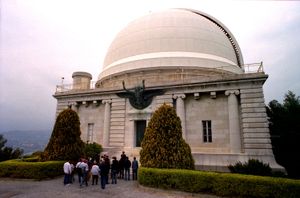
The Observatoire de Nice (Nice Observatory) is located on the summit of Mont Gros. The observatory was established in 1879 by the banker Raphaël Bischoffsheim. The architect was Charles Garnier; Gustave Eiffel designed the main dome.
The 76-cm (30-inch) refractor telescope that became operational in 1888 was at that time the world's largest telescope.
التعليم
- جامعة نيس صوفيا أنيپولي
- جامعة پيير وماري كوري
- EDHEC Business School
- IPAG Business School
- WLE French Language Immersion Program (USD)
- CERAM Sophia Antipolis - ESC Nice
تضم نيس العديد من المدارس التحضيرية التي تعد الطلبة لدخول الكليات.
المدن الشقيقة
نيس على علاقة توأمة مع المدن التالية:
- توأمات نشطة:
- توأمات أخرى:
 Alicante, إسپانيا
Alicante, إسپانيا Cartagena, كولومبيا
Cartagena, كولومبيا Antananarivo, مدغشقر
Antananarivo, مدغشقر كاپ تاون، جنوب أفريقيا
كاپ تاون، جنوب أفريقيا هيوستن، الولايات المتحدة
هيوستن، الولايات المتحدة كاماكورا, اليابان
كاماكورا, اليابان Libreville, الگابون
Libreville, الگابون مانيلا، الفلپين
مانيلا، الفلپين نتانيا، إسرائيل
نتانيا، إسرائيل Nouméa, فرنسا
Nouméa, فرنسا Phuket, تايلند
Phuket, تايلند ريو دي جانيرو، البرازيل
ريو دي جانيرو، البرازيل Saint Denis, فرنسا
Saint Denis, فرنسا Santa Cruz de Tenerife, إسپانيا
Santa Cruz de Tenerife, إسپانيا Sorrento, إيطاليا
Sorrento, إيطاليا Yerevan, أرمنيا
Yerevan, أرمنيا
حوادث
هجوم 2020
في 29 أكتوبر 2020، قُتل ثلاثة أشخاص على الأقل وأصيب عشرات آخرون في هجوم بسكين وقع بالقرب من كنيسة نوتردام في مدينة نيس الفرنسية. وذكرت مصادر من الشرطة الفرنسية أنها أوقفت منفِّذ الهجوم البالغ من العمر 25 عاماً. وقررت نيابة مكافحة الإرهاب فتح تحقيق في قتل ومحاولة قتل بعد الهجوم.[48]
وأكد مصدر قريب من التحقيق أن منفذ الهجوم بسكين الذي قتل ثلاثة أشخاص أحدهم نحراً، وجرح آخرين الخميس في كنيسة وسط نيس بجنوب شرق فرنسا هتف "الله أكبر" خلال تنفيذه الاعتداء. وأضاف المصدر أن المهاجم الذي أصيب في إطلاق نار خلال اعتقاله، قال إن اسمه إبراهيم وعمره 25 عاماً.
وأوضح مصدر في الشرطة أن ضحايا الهجوم هم رجلان وامرأة، قتلت الأخيرة وأحد الرجلين في كنيسة نوتردام بينما توفي ثالث بعد إصابته بجروح خطيرة في حانة قريبة كان قد لجأ إليها.
انظر أيضاً
- مقاطعة نيس
- Albert Spaggiari
- Bishopric of Nice
- كرنڤال نيس
- Catherine Ségurane
- Cimetière du Château
- Cimiez
- المعهد الاوروپي للدراسات الدولية العليا
- مرصد نيس
- OGC Nice
- Rugby Nice Côte d'Azur Université-Racing
- باريس-نيس
- صوفيا أنيپولي
- معاهدة نيس
- Hotel Negresco
- المريديان
- نيس لا بلا
المصادر والمراجع
- ^ "Répertoire national des élus: les maires" (in الفرنسية). data.gouv.fr, Plateforme ouverte des données publiques françaises. 13 سبتمبر 2022.
- ^ أ ب ت ث Comparateur de territoire: Aire d'attraction des villes 2020 de Nice (017), Unité urbaine 2020 de Nice (06701), Commune de Nice (06088), INSEE, retrieved 20 June 2022.
- ^ Demographia: World Urban Areas Archived 7 فبراير 2020 at the Wayback Machine, Demographia.com, April 2016
- ^ أ ب Ruggiero, Alain, ed. (2006). Nouvelle histoire de Nice. Toulouse: Privat. pp. 17–18. ISBN 978-2-7089-8335-9.
- ^ Alain Ruggiero, op. cit., p. 137
- ^ "Nice, France travel. Comprehensive guide to Nice". Europe-cities.com. Archived from the original on 17 أبريل 2011. Retrieved 3 أبريل 2011.
- ^ أ ب "Southern French city of Nice earns UNESCO world heritage status". France 24. 27 يوليو 2021. Retrieved 30 يوليو 2021.
- ^ Un savoir-faire et un équipement complet en matière d'accueil, Urban community of Nice Côte d'Azur website Archived 24 فبراير 2009 at the Wayback Machine
- ^ Les chiffres clés du tourisme à Nice, site municipal Archived 17 ديسمبر 2007 at the Wayback Machine
- ^ "Union des aéroports français – Résultats d'activité des aéroports français 2007 – Trafic passagers 2007 classement – page 8" (PDF). Archived from the original (PDF) on 29 فبراير 2012. Retrieved 3 أبريل 2011.
- ^ أ ب ت ث ج ح خ د ذ ر ز One or more of the preceding sentences incorporates text from a publication now in the public domain: Chisholm, Hugh, ed. (1911). . دائرة المعارف البريطانية. Vol. 19 (eleventh ed.). Cambridge University Press. pp. 646–647.
{{cite encyclopedia}}: Cite has empty unknown parameter:|coauthors=(help) - ^ "Le Nouveau venu" (in الفرنسية). Musée de Paléontologie Humaine de Terra Amata. Archived from the original on 11 مارس 2009. Retrieved 5 مارس 2009.
- ^ A. G. Wintle; M. J: Aitken (يوليو 1997). "Thermoluminescence dating of burnt flint: application to a Lower Paleolithic site, Terra Amata". Archaeometry. 19 (2): 111–130. doi:10.1111/j.1475-4754.1977.tb00189.x. Archived from the original on 29 يونيو 2017. Retrieved 5 مارس 2009.
- ^ "The Chsteau of Villeneuve-Loubet". Villeneuve-Loubet Guide and Hotels. Archived from the original on 26 أبريل 2014. Retrieved 30 سبتمبر 2009.
- ^ Ruggiero, Alain (2006). Nouvelle Histoire de Nice (in الفرنسية).
- ^ Kendall Adams, Charles (1873). "Universal Suffrage under Napoleon III". The North American Review. 0117: 360–370.
- ^ Dotto De' Dauli, Carlo (1873). Nizza, o Il confine d'Italia ad Occidente (in الإيطالية).
- ^ Large, Didier (1996). "La situation linguistique dans le comté de Nice avant le rattachement à la France". Recherches régionales Côte d'Azur et contrées limitrophes.
- ^ Paul Gubbins and Mike Holt (2002). Beyond Boundaries: Language and Identity in Contemporary Europe (in الإنجليزية). pp. 91–100.
- ^ Peirone, Fulvio (2011). Per Torino da Nizza e Savoia. Le opzioni del 1860 per la cittadinanza torinese, da un fondo dell'archivio storico della città di Torino (in الإيطالية). Turin.
{{cite book}}: CS1 maint: location missing publisher (link) - ^ ""Un nizzardo su quattro prese la via dell'esilio" in seguito all'unità d'Italia, dice lo scrittore Casalino Pierluigi" (in الإيطالية). 28 أغسطس 2017. Archived from the original on 19 فبراير 2020. Retrieved 14 مايو 2021.
- ^ "Nizza e il suo futuro" (in الإيطالية). Liberà Nissa. Archived from the original on 3 فبراير 2019. Retrieved 26 ديسمبر 2018.
- ^ أ ب Courrière, Henri (2007). "Les troubles de février 1871 à Nice". Cahiers de la Méditerranée (74): 179–208. doi:10.4000/cdlm.2693.
- ^ Paul Gubbins and Mine Holt (2002). Beyond Boundaries: Language and Identity in Contemporary Europe. pp. 91–100.
- ^ "Il Nizzardo" (PDF) (in الإيطالية). Retrieved 17 مايو 2021.
- ^ "Un'Italia sconfinata" (in الإيطالية). 20 فبراير 2009. Retrieved 17 مايو 2021.
- ^ "Nice Grand Prix". Best of Nice. Archived from the original on 25 سبتمبر 2019. Retrieved 25 سبتمبر 2019.
- ^ Léon Poliakov, La conditions des Juifs sous l'occupation italienne, Paris, CDJC, 1946 and bibliographies of Angelo Donati and Père Marie-Benoît
- ^ Pogatchnik, Shawn (23 مايو 2002). "Irish referendum on Nice Treaty 'doomed to fail again'". The Independent. Archived from the original on 12 مايو 2020. Retrieved 17 مارس 2020.
- ^ Almasy, Steve (14 يوليو 2016). "Nice mayor: 'Tens of dead' when truck runs into crowd". CNN. Archived from the original on 15 يوليو 2016. Retrieved 14 يوليو 2016.
- ^ "Nice truck attack claims 86th victim". Star Tribune. 19 أغسطس 2016. Archived from the original on 21 أغسطس 2016. Retrieved 17 نوفمبر 2016.
- ^ "Nice attack: At least 84 killed during Bastille Day celebrations". BBC News. 15 يوليو 2016. Archived from the original on 18 أبريل 2019. Retrieved 15 يوليو 2016.
- ^ Duffield, Charlie (14 يوليو 2020). "Nice attack: What happened in the 2016 Bastille Day killings". www.standard.co.uk (in الإنجليزية). Archived from the original on 27 يوليو 2020. Retrieved 25 فبراير 2021.
- ^ Gaillard, Eric (29 أكتوبر 2020). "Three dead as woman beheaded in knife attack at French church". Reuters. Archived from the original on 30 أكتوبر 2020. Retrieved 29 أكتوبر 2020.
- ^ Tidman, Zoe (29 أكتوبر 2020). "Nice stabbings: Woman decapitated and others killed in France knife attack". The Independent. Archived from the original on 29 أكتوبر 2020. Retrieved 29 أكتوبر 2020.
- ^ Nash, Dennison (1979). "The rise and fall of an aristocratic tourist culture: Nice: 1763–1936". Annals of Tourism Research. 6 (1): 65. doi:10.1016/0160-7383(79)90095-1.
- ^ Mitchell, L.G. (1994). "Voyages au pays des mangeurs de grenouilles: La France vue par les Britanniques du XVII siecle a nos jours". The English Historical Review. 109 (433): 1018. doi:10.1093/ehr/CXI.433.1018. Archived from the original on 31 يناير 2021. Retrieved 4 أكتوبر 2020.
- ^ أ ب ت ث ج ح Ralph Schor (Edited by), Dictionnaire historique et biographique du comté de Nice (Historical and biographical dictionary of the County of Nice), Nice, Serre, 2002, ISBN 978-2-86410-366-0, pp.22–23 (in فرنسية)
- ^ "French Riviera hit by snowfall Archived 12 أغسطس 2018 at the Wayback Machine". The Local fr. The Local Europe AB. 26 February 2018.
- ^ "Nice (06)" (PDF). Fiche Climatologique: Statistiques 1991–2020 et records (in الفرنسية). Meteo France. Archived from the original (PDF) on 6 مارس 2018. Retrieved 14 يوليو 2022.
- ^ أ ب "Nice, France – Climate data". Weather Atlas. Archived from the original on 12 فبراير 2020. Retrieved 15 أبريل 2017.
- ^ "Nice (07690) – WMO Weather Station". NOAA. Archived from the original on 22 يوليو 2019. Retrieved 22 يوليو 2019.
- ^ "Normes et records 1961–1990: Nice – Côte d'Azur (06) – altitude 4m" (in الفرنسية). Infoclimat. Archived from the original on 15 مارس 2016. Retrieved 10 مارس 2018.
- ^ "Technology Parks to promote regional economic transformation | Interreg Europe – Sharing solutions for better policy". www.interregeurope.eu (in الإنجليزية). Retrieved 8 فبراير 2023.
- ^ "Global city GDP 2011". Brookings Institution. Archived from the original on 5 يونيو 2013. Retrieved 4 مارس 2013.
- ^ قالب:Cassini-Ehess
- ^ Population en historique depuis 1968 Archived 10 مارس 2021 at the Wayback Machine, INSEE
- ^ "ثلاثة قتلى على الأقل في هجوم بسكين بمدينة نيس الفرنسية". فرانس 24. 29 أكتوبر 2020. Retrieved 29 أكتوبر 2020.
 هذه المقالة تضم نصاً من مطبوعة هي الآن مشاع: هربرمان, تشارلز, ed. (1913). الموسوعة الكاثوليكية. Robert Appleton Company.
هذه المقالة تضم نصاً من مطبوعة هي الآن مشاع: هربرمان, تشارلز, ed. (1913). الموسوعة الكاثوليكية. Robert Appleton Company. {{cite encyclopedia}}: Cite has empty unknown parameters:|1=,|coauthors=, and|month=(help); Invalid|ref=harv(help); Missing or empty|title=(help)
وصلات خارجية
- (إنگليزية) & (بالفرنسية) NiceRendezVous official site
- (إنگليزية) & (بالفرنسية) Nice Carnaval
- (إنگليزية) & (بالفرنسية) Dances and traditional musics from Nice
- نيس travel guide from Wikitravel
- (بالفرنسية) Nice official site
- CS1 الفرنسية-language sources (fr)
- مقالات المعرفة المحتوية على معلومات من دائرة المعارف البريطانية طبعة 1911
- Wikipedia articles incorporating text from the 1911 Encyclopædia Britannica
- CS1 الإيطالية-language sources (it)
- CS1 maint: location missing publisher
- Articles with فرنسية-language sources (fr)
- Short description is different from Wikidata
- Use dmy dates from March 2017
- Articles containing أوكسيتان (بعد 1500)-language text
- Pages using multiple image with auto scaled images
- Pages using infobox settlement with possible motto list
- Coordinates on Wikidata
- صفحات تستخدم جدول مستوطنة بقائمة محتملة لصفات المواطن
- Pages using infobox settlement with image map1 but not image map
- Articles containing إيطالية-language text
- Articles containing Ligurian-language text
- Articles containing Ancient Greek (to 1453)-language text
- Articles containing لاتينية-language text
- Articles containing فرنسية-language text
- Articles with hatnote templates targeting a nonexistent page
- Articles with unsourced statements from November 2020
- Articles with unsourced statements from November 2017
- Articles with unsourced statements from October 2017
- Articles with unsourced statements from January 2018
- المقالات needing additional references from July 2016
- كل المقالات needing additional references
- المقالات needing additional references from January 2018
- المقالات needing additional references from November 2017
- مقالات فيها عبارات متقادمة منذ 2018
- جميع المقالات التي فيها عبارات متقادمة
- CS1 errors: missing title
- Articles incorporating text from the 1913 Catholic Encyclopedia with no article parameter
- مدن فرنسا
- كميونات الألب البحري
- نيس
- مدن وبلدات كرنڤالات
- Prefectures in France
- مواقع تراث عالمي في فرنسا
- Massalian colonies
- صفحات مع الخرائط

